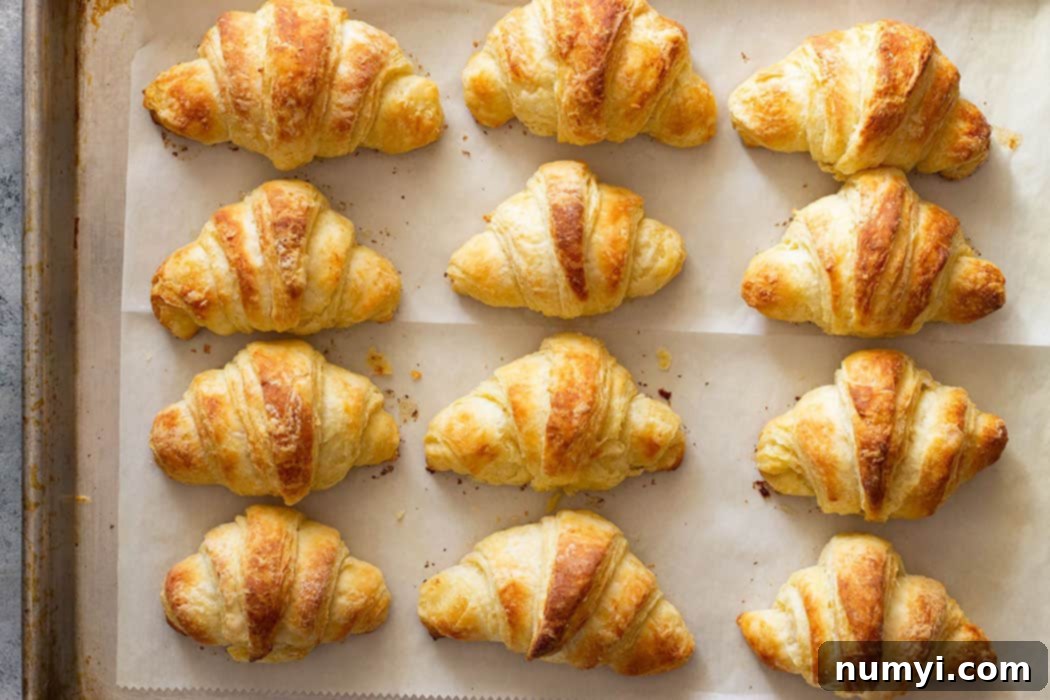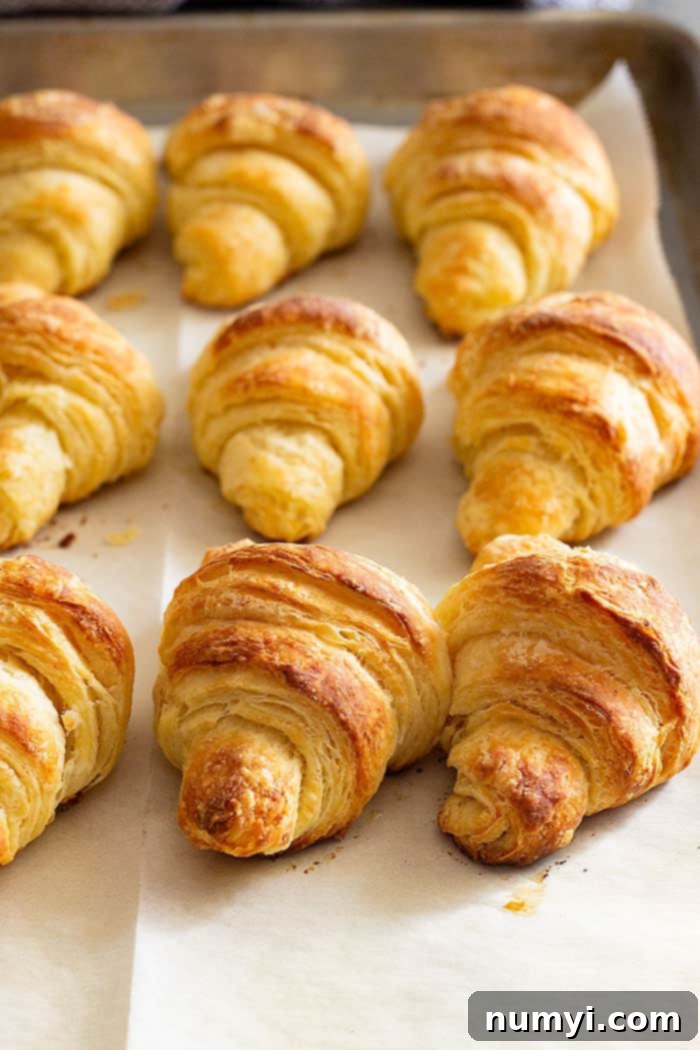Ultimate Flaky Homemade Crescent Rolls: Easy Recipe & Essential Tips
Imagine sinking your teeth into a warm, tender, and incredibly flaky crescent roll, fresh from your own oven. These homemade crescent rolls are not only a delightful addition to any meal but are also surprisingly easy to make, especially when compared to their more intricate cousin, the croissant! Get ready to impress your family and friends with these buttery, melt-in-your-mouth rolls.

*Originally published November 2013. Photos, text, and recipe updated and expanded for clarity and improved SEO.*
Crafting Truly Flaky Crescent Rolls from Scratch
Are you on a quest for homemade crescent rolls that boast those coveted flaky layers, just like the ones from a can, but with superior taste and freshness? Look no further – this recipe is specifically designed to deliver exactly that! Many traditional crescent roll recipes tend to produce a roll that’s simply “crescent-shaped” but lacks the distinct, airy flakiness we all adore.
Our secret lies in adapting a classic biscuit technique to a yeast dough. Biscuits are renowned for their flaky texture, achieved by cutting cold butter into the flour, which then creates steam pockets as it bakes. By applying this same principle to a yeasted dough, we unlock a world of tender, buttery, and beautifully layered crescent rolls that rise to perfection. This method ensures that every bite is light, airy, and utterly delicious.
Beyond these sensational crescent rolls, exploring other bread recipes can truly elevate your baking skills. For instance, our Flaky Buttermilk Biscuits offer another masterclass in achieving perfect layers. If you’re in the mood for something heartier, our Buttermilk Cornbread provides a delightful rustic option, while the incredibly simple Beer Bread is perfect for a quick and flavorful side.

Essential Tips for Perfect Flaky Layers
Achieving those desirable flaky layers in your homemade crescent rolls comes down to a few key techniques. Understanding the role of ingredients and how they interact is crucial for success:
The Magic of Cold Butter
- The cornerstone of flaky pastries is cold butter. As the butter bakes, it melts and releases steam, which then pushes apart the layers of dough, creating those distinctive air pockets. This process is also what contributes to a wonderfully crispy exterior while keeping the interior tender.
- One of the beauties of this particular crescent roll recipe is its efficiency. We’ve minimized chilling time, finding that a single chilling period for the dough is sufficient to achieve excellent flakiness, making the process much quicker than many other laminated doughs.
Cutting the Butter Just Right
- When incorporating the butter into your flour mixture, aim for chunks that are slightly larger than peas. This size is ideal because it allows the butter to create distinct layers without fully integrating into the dough too early.

Why Avoid Graters or Food Processors for Butter
- While cheese graters or food processors might seem like convenient tools for cutting in butter, they are not recommended for this recipe. These methods can break down the butter too finely, causing it to disappear into the dough as you work it.
- Without those distinct pieces of butter, you won’t get those lovely flaky layers. This differs from biscuits, where minimal handling allows finely cut butter to still create flakiness. However, with yeast dough, which requires more handling and rising time, larger butter chunks are essential to maintain their integrity and deliver the desired texture.
Dough Hydration and Handling
- Pay close attention to the dough’s consistency. Start with the recommended amount of milk and add more gradually if the dough appears too dry. The goal is a dough that comes together into a cohesive ball without being overly sticky. Slight variations in flour or humidity can affect liquid absorption, so trust your judgment.
- While working the dough, avoid over-kneading, which can develop too much gluten and result in a tough roll. The folding technique in this recipe gently develops the gluten while distributing the butter for flakiness.

Crescent Rolls vs. Croissants: Understanding the Difference
A common question arises when discussing crescent-shaped pastries: are crescent rolls and croissants the same? In my opinion, and from a baking perspective, they are distinctly different, though both undeniably delicious!
The Art of Croissant Lamination
Traditional croissants are a true labor of love, requiring a significant time commitment and a specific technique known as “lamination.” This intricate process involves repeatedly folding a slab of butter into a yeast dough, chilling, rolling, and folding again, often many times over several hours, or even days. Each fold creates hundreds of ultra-thin layers of butter and dough. When baked, the butter melts and creates steam, separating these layers into the iconic airy, crisp, and exceptionally flaky texture that defines a classic croissant.
Our Simplified Flaky Crescent Rolls
While these homemade crescent rolls also incorporate butter into the dough to achieve flakiness, the method is significantly less complex and much faster than traditional croissant making. We utilize a modified technique inspired by biscuits, where cold butter chunks are cut into the dough and then gently folded and rolled. This approach yields wonderfully flaky layers without the intensive, multi-stage lamination process required for croissants. It’s a fantastic way to enjoy the buttery, layered goodness without the extensive commitment. Now that’s truly “my kind of roll” – delicious results with achievable effort!

Can You Make These Flaky Crescent Rolls Ahead of Time?
Absolutely! These crescent rolls are incredibly accommodating to your schedule, making them perfect for holiday meals or busy weeknights when you want fresh-baked goodness without the last-minute rush. There are a few excellent make-ahead options:
Refrigerate Unbaked Dough for Up to 24 Hours
You can prepare the recipe through step four – after shaping the rolls but before their final rise. Instead of letting them rise in a warm place, simply cover the shaped rolls loosely with plastic wrap and place them in the refrigerator for up to 24 hours. The cold temperature will significantly slow down the yeast activity.
When you’re ready to bake, remove the rolls from the refrigerator and let them come to room temperature and rise in a warm spot. This crucial step can take anywhere from 1.5 to 3 hours, depending on the ambient temperature. Be patient; a proper second rise is essential for light and fluffy rolls. Always ensure they remain covered during this time to prevent them from drying out and forming a skin.
Freezing Baked Crescent Rolls
For even longer storage, you can freeze baked crescent rolls. Once completely cooled, store them in an airtight container or a heavy-duty freezer bag for up to 2 months. To serve, simply remove them from the freezer and allow them to defrost on the counter overnight, or gently warm them in a low oven (around 300°F/150°C) until heated through.
Freezing Unbaked Rolls (with a note of caution)
While it’s possible to freeze unbaked rolls, this method is slightly trickier. After shaping, flash-freeze the rolls on a baking sheet until solid, then transfer to a freezer bag. When ready to bake, thaw them overnight in the refrigerator, then let them rise at room temperature until doubled before baking. The yeast might be slightly less active after freezing, so ensure they get a good, long rise.
Serving Suggestions for Your Homemade Crescent Rolls
These versatile flaky crescent rolls are a fantastic accompaniment to a wide variety of meals and occasions. Here are some ideas:
- Holiday Feasts: They are a classic addition to Thanksgiving, Christmas, or Easter dinners, pairing perfectly with roasted turkey, ham, and all your favorite side dishes.
- Soups and Stews: Their buttery flakiness is wonderful for soaking up rich broths and gravies.
- Breakfast or Brunch: Serve them plain with butter and jam, or use them to make mini breakfast sandwiches with eggs and cheese.
- Weeknight Dinners: Elevate any casual meal, from roast chicken to pasta dishes, with a side of warm, homemade bread.
- Potlucks and Gatherings: They are always a crowd-pleaser and disappear quickly!
Ingredient Spotlight & Possible Substitutions
While the recipe relies on specific ingredients for its signature flakiness, here are some points on what makes them great and potential considerations:
- All-Purpose Flour: Standard all-purpose flour works best here, providing the right balance of gluten for structure without being too dense. Whole wheat flour can be used for a portion, but might yield a slightly denser roll.
- Cold Butter: As discussed, cold butter is non-negotiable for flakiness. Do not substitute with margarine or softened butter. Unsalted butter is preferred so you can control the salt level.
- Active Dry Yeast: Ensure your yeast is fresh and active. If using instant yeast, you might not need to proof it separately; just add it directly to the dry ingredients.
- Milk: Any type of dairy milk (whole, 2%, or skim) will work. For a richer flavor, whole milk is recommended. Non-dairy milk alternatives can be used, but may slightly alter the texture.
- Eggs: Large eggs add richness and help bind the dough.
Troubleshooting Common Crescent Roll Issues
Even experienced bakers can sometimes run into snags. Here’s how to tackle common problems:
- Rolls aren’t flaky: This is almost always due to butter that wasn’t cold enough or was cut too finely. Ensure butter is very cold and in pea-sized chunks. Also, avoid overworking the dough.
- Rolls are dense: Could be due to over-kneading (developing too much gluten), insufficient rising time (under-proofed), or using old/inactive yeast. Make sure your yeast is fresh and give the rolls ample time to rise.
- Rolls are too flat or spread out: This often happens if the dough is over-proofed. The yeast consumes too much sugar and runs out of steam during baking, causing the structure to collapse. Keep an eye on the rising process and don’t let them go past “doubled in size.”
- Rolls are dry: Overbaking is a common culprit. Keep an eye on the oven and remove them as soon as they are golden brown. Ensure your dough isn’t too dry from the start – add enough milk!
Rating: Not yet rated
Crescent Rolls

Ingredients
- 3¾ cups (430g) all purpose flour
- ¼ cup (55g) sugar
- 1 tablespoon active dry yeast
- 1¼ teaspoon salt
- 1 cup (226g) very cold butter, cubed
- 1-1½ cups (240+ml) milk
- 2 large eggs
Instructions
-
In a large bowl, combine the flour, sugar, yeast, and salt. Using a pastry cutter, cut in the very cold butter until you have chunks a little larger than peas.
-
In a small bowl, combine the milk and eggs, then stir into the flour mixture until it forms a cohesive ball. Start with 1 cup of milk and add more if necessary (up to 1½ cups) until the dough comes together. If there is only a little flour left in the bowl, you can briefly knead the dough to finish bringing it together. If the dough is still pretty dry and having trouble coming together, add in more milk, one tablespoon at a time. Wrap the dough in plastic wrap and chill for 30 minutes.
-
Lightly dust a work surface with flour and divide the chilled dough into 3 equal portions. Take one portion and roll it into a long rectangle (approximately 12×6 inches). Fold the rectangle into thirds (like a letter). Turn the dough a quarter turn, and roll it into another long rectangle. Fold into thirds again. Repeat this rolling and folding process one more time. Finally, roll the dough into a rectangle about 1/4″ thick (sometimes yours might be a little thicker, which is fine).
-
Cut the large rectangle into 8 triangles. Starting at the wide end, gently roll up each triangle towards the point to form a crescent shape. Place the rolled crescents on a baking sheet lined with parchment paper. Repeat this process with the remaining 2 dough portions to make a total of 24 rolls. Cover the rolls loosely with plastic wrap or a clean kitchen towel and place them in a warm area to rise until they have doubled in size (this can take 1-2 hours, depending on the warmth of your room).
-
While the rolls are rising, preheat your oven to 400 degrees F (200 degrees C). Once the oven is preheated and the rolls have doubled in size, bake for 10-12 minutes or until they are beautifully golden brown on top and bottom. Serve warm and enjoy!
Video
Notes
- Make-Ahead Option: As detailed above, you can prepare the recipe through step four (shaping the rolls) and then place them in the refrigerator for up to 24 hours. Remember to remove them from the refrigerator a couple of hours before baking to allow them to warm up and rise adequately.
- Storage: Store any leftover baked rolls in an airtight container or plastic bag at room temperature for up to 3-5 days to maintain their freshness.
- To Freeze Baked Rolls: Freeze completely cooled, baked rolls in an airtight container or freezer-safe plastic bag for up to 2 months. To enjoy, remove from freezer and defrost on the counter overnight, or warm gently in a low oven.
- Nutrition Facts Disclaimer: Nutritional information is an estimate based on average values and may vary depending on specific brands and ingredient choices. It is provided for informational purposes only.
Nutrition
Calories: 156kcal |
Carbohydrates: 31g |
Protein: 4g |
Fat: 8.5g |
Saturated Fat: 5g |
Cholesterol: 35mg |
Sodium: 201mg |
Potassium: 61mg |
Fiber: 1g |
Sugar: 3g |
Vitamin A: 280IU |
Calcium: 21mg |
Iron: 1.8mg
Did you make this?
Let me know by sharing a picture and tagging @countryside_cravings on Instagram
Why Homemade Crescent Rolls Are Always Better
While canned crescent rolls are convenient, nothing truly compares to the taste and texture of freshly baked homemade rolls. The aroma filling your kitchen, the warmth in your hands, and the unparalleled flavor and flakiness are rewards that are well worth the effort. You control the quality of ingredients, ensuring no artificial flavors or preservatives, just pure, wholesome goodness. Plus, the sense of accomplishment from baking something so delicious from scratch is incredibly satisfying.
Ready to Bake Your Best Crescent Rolls Yet?
With this comprehensive guide and easy-to-follow recipe, you’re now equipped to bake the most tender, buttery, and flaky homemade crescent rolls you’ve ever tasted. Whether for a special holiday meal, a comforting weeknight dinner, or a delightful brunch, these rolls are sure to become a cherished family favorite. Don’t be intimidated by the process; embrace the joy of baking and prepare to be amazed by the delicious results. Happy baking!
